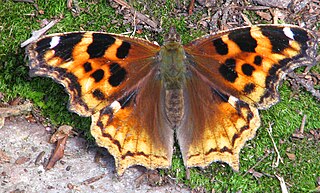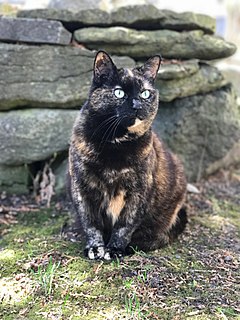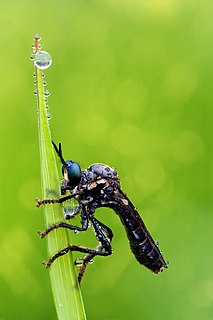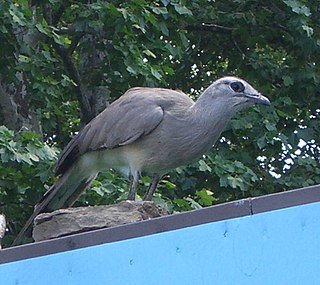
The kittiwakes are two closely related seabird species in the gull family Laridae, the black-legged kittiwake and the red-legged kittiwake. The epithets "black-legged" and "red-legged" are used to distinguish the two species in North America, but in Europe, where Rissa. brevirostris is not found, the black-legged kittiwake is often known simply as kittiwake, or more colloquially in some areas as tickleass or tickleace. The name is derived from its call, a shrill 'kittee-wa-aaake, kitte-wa-aaake'. The genus name Rissa is from the Icelandic name Rita for the black-legged kittiwake.

The small tortoiseshell is a colourful Eurasian butterfly in the family Nymphalidae. Adults feed on nectar and may hibernate over winter; in warmer climates they may have two broods in a season. While the dorsal surface of the wings is vividly marked, the ventral surface is drab, providing camouflage. Eggs are laid on the common nettle, on which the larvae feed.

The Angora rabbit, which is one of the oldest types of domestic rabbit, is bred for the long fibers of its coat, known as Angora wool, that are gathered by shearing, combing, or plucking. Because rabbits do not possess the same allergy-causing qualities as many other animals, their wool is an important alternative. There are at least 11 distinct breeds of Angora rabbit, four of which are currently recognized by the American Rabbit Breeders Association (ARBA): English Angora, French Angora, Giant Angora, and Satin Angora. Others include: German Angora, Chinese Angora, Finnish Angora, Japanese Angora, Korean Angora, Russian Angora, St. Lucian Angora, and Swiss Angora.

A strikebreaker is a person who works despite an ongoing strike. Strikebreakers are usually individuals who were not employed by the company prior to the trade union dispute, but rather hired after or during the strike to keep the organization running. "Strikebreakers" may also refer to workers who cross picket lines to work.
Blackleg, blacklegs or black-legged may refer to:

The California tortoiseshell is a butterfly of the family Nymphalidae.

Seaton Delaval is a village in Northumberland, England, with a population of 4,371. It is the largest of the five villages in Seaton Valley and is the site of Seaton Delaval Hall, the masterpiece completed by Sir John Vanbrugh in 1727.

Blackleg, black quarter, quarter evil, or quarter ill is an infectious bacterial disease most commonly caused by Clostridium chauvoei, a Gram-positive bacterial species. It is seen in livestock all over the world, usually affecting cattle, sheep, and goats. It has been seen occasionally in farmed bison and deer. The acute nature of the disease makes successful treatment difficult, and the efficacy of the commonly used vaccine is disputed.
"Blackleg Miner" is a 19th-century English folk song, originally from Northumberland. Its Roud number is 3193. The song is one of the most controversial English folk songs owing to its depiction of violence against strikebreakers.

Tortoiseshell or tortoise shell is a material produced from the shells of the larger species of tortoise and turtle, mainly the hawksbill sea turtle, which is an endangered species largely because of its exploitation for the material. The large size, fine colour and unusual form of the hawksbill's scutes make it especially suitable. The distinctive patterning is referred to in names such as the tortoiseshell cat, several breeds of guinea pig, and the common names of several species of the butterfly genera Nymphalis and Aglais, and some other uses.

Nymphalis, commonly known as the tortoiseshells or anglewing butterflies, is a genus of brush-footed butterflies. The genera Aglais, Inachis, Polygonia and Kaniska, were sometimes included as subgenera of Nymphalis but they are by some people considered to be unique genera. See also anglewing butterflies. For other butterflies named tortoiseshells, see the genus, Aglais.

Calico cats are domestic cats with a spotted or particolored coat that is predominantly white, with patches of two other colors. Outside North America, the pattern is more usually called tortoiseshell and white. In the province of Quebec, Canada, they are sometimes called chatte d'Espagne. Other names include brindle, tricolor cat, tobi mi-ke, and lapjeskat ; calicoes with diluted coloration have been called calimanco or clouded tiger. Occasionally, the tri-color calico coloration is combined with a tabby patterning; this calico-patched tabby is called a caliby.

Nymphalis xanthomelas, the scarce tortoiseshell, is a species of nymphalid butterfly found in eastern Europe and Asia. This butterfly is also referred as yellow-legged tortoiseshell or large tortoiseshell.

Aglais milberti, the fire-rim tortoiseshell or Milbert's tortoiseshell, is the only species of Aglais that occurs in North America.

Ixodes pacificus, the Western black-legged tick, is a species of Ixodes, a parasitic tick found on the western coast of North America. It is the principal vector of Lyme Disease in that region.

Tortoiseshell is a cat coat coloring named for its similarity to tortoiseshell material. Like calicos, tortoiseshell cats are almost exclusively female. Male tortoiseshells are rare and are usually sterile.
Colours of the Syrian hamster can be described in three ways: as "self", "agouti" or "combinations". Self colours are a consistent coat colour with the same colour topcoat and undercoat. Agouti hamsters have a different, lighter undercoat and markings around the eyes. Combinations are produced when two self or agouti colours are present.

Blackleg is a plant disease of potato caused by pectolytic bacteria that can result in stunting, wilting, chlorosis of leaves, necrosis of several tissues, a decline in yield, and at times the death of the potato plant. The term “blackleg” originates from the typical blackening and decay of the lower stem portion, or “leg", of the plant.





















